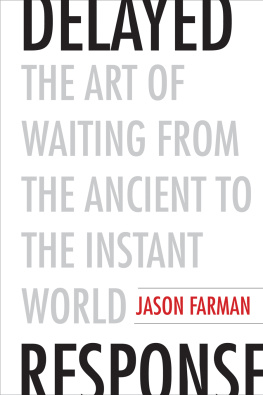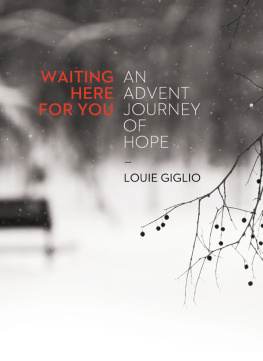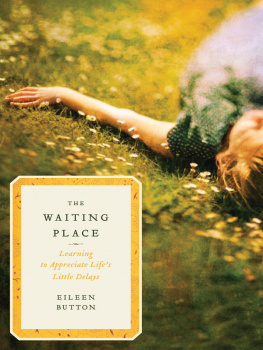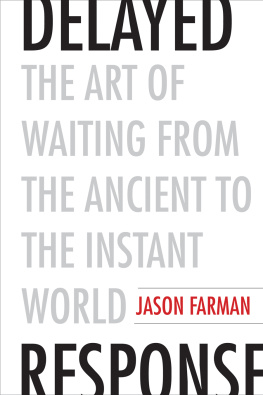DELAYED RESPONSE

Published with assistance from the Alfred P. Sloan Foundation.
Published with assistance from the Louis Stern Memorial Fund.
Copyright 2018 by Jason Farman.
All rights reserved.
This book may not be reproduced, in whole or in part, including illustrations, in any form (beyond that copying permitted by Sections 107 and 108 of the U.S. Copyright Law and except by reviewers for the public press), without written permission from the publishers.
Yale University Press books may be purchased in quantity for educational, business, or promotional use. For information, please e-mail (U.K. office).
Set in New Aster type by IDS Infotech, Ltd.
Printed in the United States of America.
Library of Congress Control Number: 2018933273
ISBN 978-0-300-22567-9 (hardcover : alk. paper)
A catalogue record for this book is available from the British Library.
This paper meets the requirements of ANSI/NISO Z39.48-1992 (Permanence of Paper).
10 9 8 7 6 5 4 3 2 1
For Jonah and Noelle
In Memory of Al Pramschufer
CONTENTS
DELAYED RESPONSE
INTRODUCTION
W hy would you send a text message without text? Five years ago, as I sat in the audience at a conference in Boston, an anthropologist of Japanese popular culture described an emerging practice among teens in Japan. A teen would send a blank text message to his or her romantic partner, and the partners job was to respond with a blank message with as little time elapsed as possible. These blank texts would be sent throughout the day and established a rhythm for the relationship, as partners would respond quickly to each other, always being in contact without saying a word.
I was fascinated. The meaning of these messages was entirely dependent on how quickly someone responded, and that speedor delay, if someones partner wasnt paying adequate attentionhad significance for their relationship. The content of these messages was time. These nudges showed that each person was present despite being physically distant from the other. Waiting for a response was an interpretive moment; it was something to which the Japanese teens gave meaning.
The existence of the blank texts later proved dubious, but the idea behind them led me to write this book and to explore moments throughout history where waiting for a message was central to the message itself. For me, the story of the blank texts moved into the realm of communication media lore, serving as a founding myth that became one of the most apt descriptions of our eras relationship to messages and time. Our expectations for a quick reply, and the ways that the time lag between sending and receiving messages is interpreted, belong to a long lineage of technologies that have kept people in touch. In each culture and in every era, people have sent messages and waited for a response. We do it now with our emails and text messages, and in the past people waited for messengers running or riding on horseback, letters sealed or stamped, telegrams transmitted across oceans, and news updates printed in the morning edition. The delay between sending and receiving a message is something people have always interpreted with anxiety, hope, fear, boredom, or longing. These interpretations are powerful tools for shaping the ways that we understand human connection and intimacy. These interpretations also help unlock innovation, as we speculate about the unknown and create new ways of exploring the universe.
How quickly and how consistently people respond to messages gives a pace to their social connection. When one of the partners deviates from this rhythm, the other person is left to interpret the silence. The gap in time requires the person to fill in the blanks with meaningor, more accurately, to assign those blanks meaning. Here, silence is content. In the mobile media era, we may ask: Did the other persons phone run out of batteries? Was she called into a work meeting? Is he cheating on me?
As it turned out, no one I spoke with in Japan had ever heard of the blank text messages that teens there were purportedly sending. I traveled to Japan to interview college students who would have exchanged blank texts back in their high school days. When I brought up the idea behind the blank texts, I was greeted with blank stares. These students hadnt sent blank text messages in their lives. I sat down over lunch or drinks with my Japanese friends and colleagues, who found the story amusing and bewildering. Though they found the concept interesting and believable (Japanese teens were always coming up with inventive ways of using their phones), they had never heard of the practice. Despite speaking to dozens of college students, professors, and media professionals in Tokyo, I was never able to confirm that blank texting had ever been a part of Japanese mobile media culture.
After I returned from my trip to Japan, though, I was discussing my search for the blank text messages with colleagues at my university in the Washington, DC, area. Raffaele, my colleague who grew up in Italy, told me he participated in a similar kind of message exchange during his teenage years in Italy. He called it ringing. Ringing, it turned out, was an incredibly popular practice among Italian teenagers in the years leading up to smartphones and social media apps. Throughout the 1990s and early 2000s, it was common for Italian high schoolers to have cell phones, but using them was costly: There were no unlimited text, voice, and data plans. It was too expensive to send a casual text: I miss you. To get around the high cost of using a mobile phone, they used ringing, in which one person would call a boyfriend, girlfriend, or close friend and hang up after a single ring. The unanswered call was free and communicated a clear message. Raffaele noted that the most common sentiment a ring would convey is, Hey, Im thinking about you! Seeing a friends or a lovers name on the caller ID, it was the other persons job to call back and leave a single ring as quickly as possible. There were no words, pictures, videos, or likes with these messages; instead, time was the message. These rings echo experiences shared by anyone who has used mobile media to find and maintain a love interest: When it comes to sending messages with the person we love, waiting itself bears meaning.
As high schoolers in Italy during the early 2000s, Raffaele and his romantic interest would keep in touch by sending each other these textless messages. Though they would spend nearly every weekend hour side by side at small movie houses, at the nearby park, and at each others houses, they attended different schools and rarely saw each other during the school week. To feel connected during the time between classes, Raffaele would ring his love interest, who would send back a single ring almost immediately.
One Italian writer wrote that a ring could save your day or ruin it. Rings could connect us, to make you realize that I was thinking of you, that I remembered your existence, that your The ring conveyed all of this without a single word exchanged. The meaning of these blank exchanges was based on the time between messages and the history of a particular relationship. Once this version of blank messages entered into the anxiety-ridden landscape of teenage life, these rings created a mixture of deep emotional connection, frustration, and social expectation. Raffaele told me about times when he would exchange daily rings with his close friends, who, like his romantic interest, were people he would see regularly on the weekends but not during the school week. If there was a day when a friend didnt send or respond to a ring, Raffaele would be left to interpret that silence, feeling frustrated and hurt. Rings created a routine of keeping in touch for these teens, and they would ring each other every day, for years.
Next page









